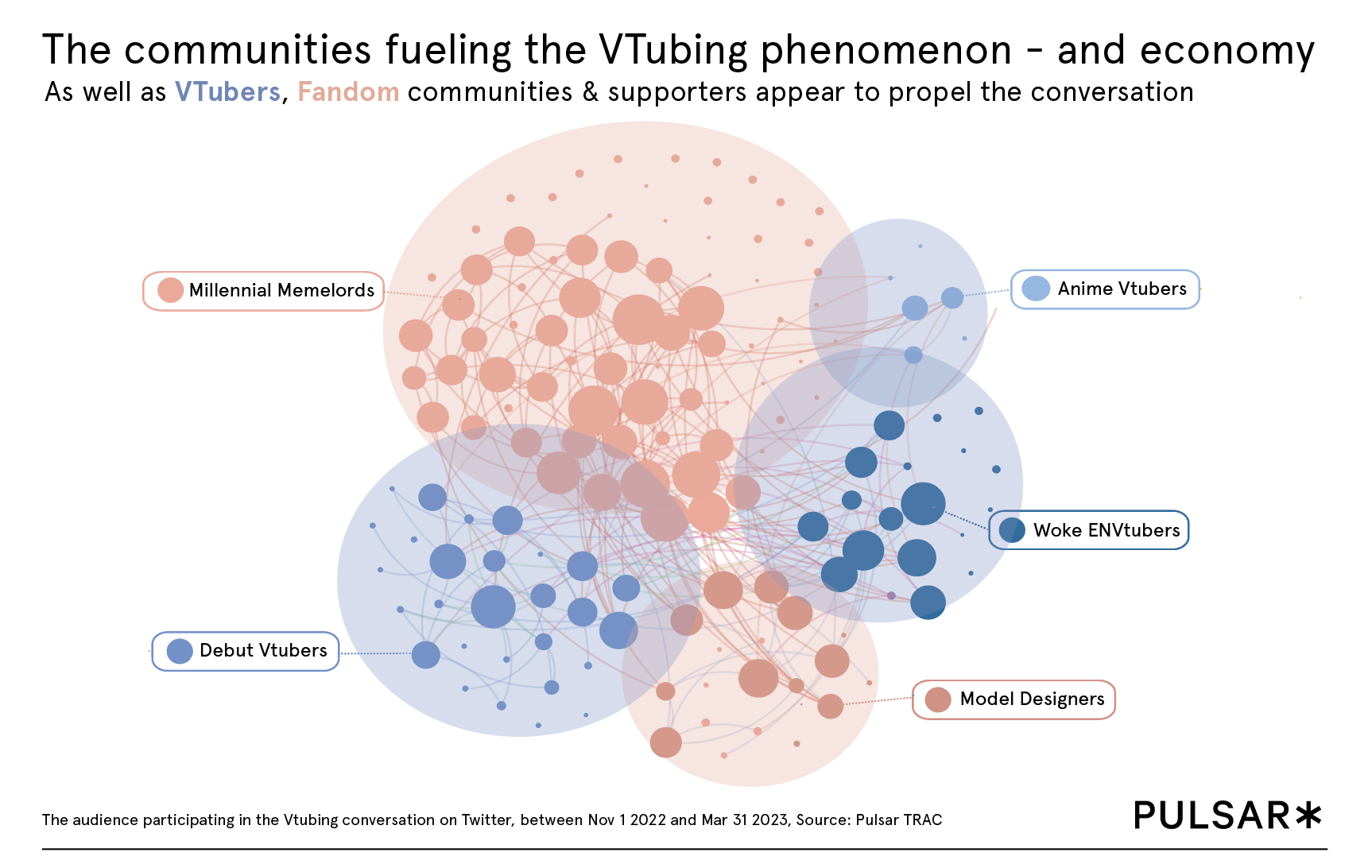
The rise of VTubing, and the audiences behind it
- Media & Entertainment
You might not have heard of Vtubing, yet. And if you work in media, marketing or with Gen Z, you might want to brush up on it.
VTubing saw explosive growth since the pandemic hit, but unlike many other trends, it has stuck around, and it keeps on growing.
So what is VTubing exactly?
VTubers (short for Virtual Youtubers) are creators who livestream on YouTube or Twitch by creating and animating a virtual avatar, rather than using their own identity and face.
It looks something like this.
I learned how to metal scream! https://t.co/FZZqk2gcCe
— 💖ironmouse😈VSHOJO💖 (@ironmouse) April 6, 2023
VTubing is particularly fascinating because it sits at a unique intersection of huge shifts in media & technology (AI, the metaverse, motion tracking and face detection software) growing cultural trends (from the creator economy and livestreaming to anime and K-pop), and key questions around identity and the self in the digital age.
Here’s what the behind-the-scenes of animating a virtual identity looks like.
Popular VTuber and Twitch streamer @codemiko received an updated version of the avatar that comes with movable fingers and improved hair physics:https://t.co/PXzpkCn3YA#vtuber #characterdesign #characterart #digitalhuman #unrealengine5 #motioncapture #mocap #codemiko pic.twitter.com/NvBjOxIZ0Z
— 80 LEVEL (@80Level) November 4, 2022
As we’ll see throughout this piece, the type of content VTubers CREATING goes way beyond traditional livestream genres like gaming and singing, extending to virtual tours of a zoo, to successful charity fundraisers, netting over $300k. And while VTubing originally emerged in the cultural context of Anime, the footprint for this type of media keeps growing, and is well on its way to becoming mainstream.
In a way, VTubing looks and feels like a vibrant and successful version of the Metaverse.
How successful? VTuber content racked up more than 1.5 billion views per month on YouTube, and Twitch says that on its platform as a genre, it grew by 467% YoY in 2021. Some of the larger VTubers have amassed followings of over 14M.
And some brands are already there, following a playbook that’s been tested a few years ago with Virtual Influencers.
Kellogg has announced their own animated VTuber of Tony the Tiger
they got a milk-coolant PC and everything man welcome to the future of brand advertising pic.twitter.com/LsFyF9JaYW
— Hunter (@HUN2R) August 16, 2022
Netflix introduced their own VTubers, while star VTuber Kizuna AI became a Valentino fashion model, and another VTuber, Mori Calliope just released an album Universal Music. Kellogg’s took another approach, turning Tony the Tiger into a VTuber and getting him to play Battle Royale against popular gamers to try and connect with new yet possibly loyal audiences.
So what are people VTubing about? Which audiences do VTubers attract? What themes emerge by looking through this? Utilizing Pulsar TRAC, We’ve drilled deep into over 1.3M conversations across Twitch, YouTube, Twitter, Reddit and more to look into what a Vtuber is and how VTubing community and its fandoms are shifting the creator – and fandom – economy.
First off - VTubing is a global phenomenon where the language of choice is English, with over 80% of the conversation happening in the US.
Redesigning my model has been interesting. Before, Vtubing was just a way for me to express my identity as a trans person but now with redesigning, I actually care about my OC's lore. She's no longer the ideal me, she is becoming a character all on her own. Its thought-provoking.
— DxD The Neon Oni (#PurrelyToTheMoon) (@DxDTheDxDAgenda) December 1, 2022
Nothing seems to be more crucial than identity in VTubing. Founded on virtual and fictional identities, VTubers are exploring that theme in depth, gravitating towards themes, personalization and self-exploration.
Streaming through an avatar gives freedom to VTubers to explore and affirm a new, projected sense of self, free from the boundaries they might feel are imposed on them by their assigned gender, sexuality, and race.
Technological leaps in motion tracking, face detection software, and now generative AI, allow VTubers to incorporate and experiment by crafting their new characters with their own lore and backstories. Community is clearly another key focus, since it’s the root of their business and of the livestream experience.
In terms of brands, the most mentioned are Gaming/Media ones like Pokemon, Minecraft, Fortnite and Apex Legends, with some music and tech brands like Adobe, for VTuber modelling and fans' enormous passion for creatives including fanart and outfit design, and Apple for its popularity in the VTubng setup essentials.
Tonight, Altare and Axel will be competing in "VTuber最協決定戦 Ver. APEX LEGENDS" organized by @ShibuyaHAL!
Send cheers to @regisaltare and @axelsyrios at #TSBWIN!
📅April 15th, 2 AM PDT | 6 PM JST
🎆https://t.co/fiV6tS7KI5
⛓https://t.co/gsnKZ7Umgb#holoTEMPUS #V最協S5 pic.twitter.com/yK4pgo0jGd— hololive production (English) (@hololivepro_EN) April 15, 2023
These vtubers remind me of something my instructor taught me. "There's many that'll claim just because they have Adobe photoshop that it makes them an artist/photographer."
And it's really shining now with the context of "oh boi, I can stream, im a vtuber now!"— Guzzie 🔞 (@GuzzieWuzzie) March 2, 2023
So which communities are discussing VTubing?

So far, the main audience communities in this conversation either identify as creators (in blue) or fans of those creators (in coral). Strongly tied to each other, these communities play off each other to discuss streams, identities, VTubing as a genre, and much more.
In terms of creators, we see Debut VTubers (who are fairly new to the scene); Woke ENVtubers (English-speaking VTubers mainly supporting LGBTQ+ communities), and Anime VTubers (focused on Asian Anime culture).
A larger flock of fans-as-creators appear in blue as the core communities on the other side: Millennial Memelords are acting as gatekeepers to edge the VTubing spirit into the mainstream, whereas Model Designers turn out to be fans-as-creators to serve the self-sustaining economy while sourcing their favorite VTubers’ models, outfits and custom merch.
Here it is!! 😀the new customizable #vtuber pet! I hope everyone will make some amazing creations!
You can buy it here (etsy): https://t.co/V26zFDJDWd
Or here (ko-fi): https://t.co/Y4FUyw97TT#VTuberAssets #VTuberUprising #vtubermodel pic.twitter.com/TshtvHNryi— Marinki (@MarinkiArt) August 18, 2023
Each of these groups, however, talks about VTubing differently.
While those creator-fan relationships in Vtubing aren’t one-way or stable and see an increased blurring of the line between audiences and fans, each of these communities has different priorities.
Newer communities to the genre like Debut & Woke English-language VTubers are most interested in community and identity aspects, while ‘older’ communities like Anime VTubers and Model Designers are now very focused on the business side of this trend, with a focus on monetization.
Millennial Memelords – the gatekeepers and the largest community – are on the other hand most interested in discussing the technology enabling successful VTubing streams.
These communities also help us shines a light on how different channels are used, and how each channel relates more or less strongly to a particular type of content.
I'm really bad with words... so let's meme to easy the pain
by u/KyoKaseki in VirtualYoutubers


